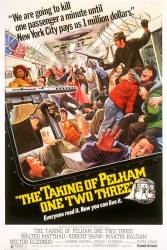Revealing mistake: When Mr. Green pulls out of 28th Street, we see him disengage the "Dead Man's Feature" (by pressing down on the throttle with his hand). However, he does not actually move the control lever to make the train move. In that position, the train is at "idle" and will not accelerate.
Factual error: The signalling board in the control tower animates Pelham 123's movements in such detail that the police can tell when it is moving and when it has stopped. Indeed the police deduce that the hijackers have abandoned the train from this. In reality this could not happen. Subway tracks are divided into variable length blocks typically hundreds of yards in length. The signalling boards are only able to show which block a train is in. The only way to tell if a train is moving is when it moves from one block to the next and the only way to estimate speed is by how quickly it occupies successive blocks. A slow-moving or stationary train are thus not able to be so easily distinguished from one another on the board.
Continuity mistake: Right after the train is hijacked by Robert Shaw at 28th Street station, there are 2 additional hostages in the front car (for a total of 19) that disappear after the train is hijacked between 23rd Street and 28th Street.
Revealing mistake: At the end of the film when Mr Blue electrocutes himself, he falls forward to the floor. As he falls you can see him move his eyes to see where he is falling.
Revealing mistake: When the men get off the train and it starts racing down the tracks, the hostages start getting frantic including the two Hispanics. In one very brief scene you can hear the Hispanic man tell the woman in Spanish to calm down but his lips aren't moving.
Character mistake: When the hijackers separate the lead car and back the rest of the train away, the conductor says in amazement, "I didn't know these things went backwards." Any subway conductor would know that trains run in either direction. Most trains relay (reverse direction) at their terminus, and any subway train can be operated from either end.





